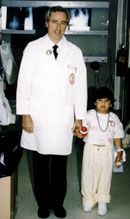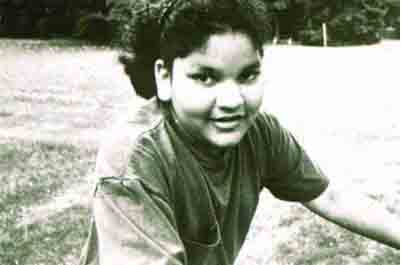(Citation 25) This video details the controversial process of gene therapy that was successfully performed on a four year old girl named Ashanti DeSilva.
|
||
  JESSE GELSINGER- was a victim of a Gene Therapy Treatment that went dreadfully wrong. For the entirety of his life, Gelsinger suffered from a rare metabolic disorder called OTC, or ornithine transcarbamylase deficiency. In order to keep the symptoms of his disorder under control, Gelsinger was kept on a diet of low protein and took 32 drugs everyday. It was Gelsinger's desire to help find a cure for OTC for future generations, so he volunteered to undergo experimental gene therapy treatment, knowing that it would probably not personally benefit him. However, knowing that this prospective treatment existed, Gelsinger was given hop that one day he could be cured. Ironically, before his treatment occured at Penn Hospital in Philedelphia, he said to a friend, "What's the worst that can happen to me?"(Citation 2). However, this treamtment proved fatal for Gelsinger. He died on September 17th, 1999, being the first documented death as a result of gene therapy. Gelsinger's gene therapy treatment was comprised of a combination of adenovirus (diluted cold virus), which served as a vector, and healthy replacement genes for his malfunctioning ones. As a result of his treatment, Gelsinger's he suffered symptoms that had never been seen in other clinical tests that had been performed (Penn had performed trials similar to Gelsinger's, on baboons, monkeys, mice, and another human. They saw no symptoms similar to those that Gelsinger suffered). Doctors are still not sure exactly what happened, but they suspected that he went through an extreme inflammatory reaction in response to the vectors he recieved. He developed jaundice and a blood-clotting disorder,
eventually having his kidney, lungs, and brain lose function. As a result of this case, the Gelsinger family sued Penn and the government suspended all other gene therapy research that was going on at Penn. This case served as an example of gene therapy gone bad.  |
ASHANTI DESILVA-The first successful case of Gene Therapy occurred in the 1990s on a young girl named Ashanti DeSilva, a victim of the recessive metabolic disorder, ADA deficiency, which made her immune system weak and vulnerable to nearly every virus. She lacked ability to produce a key enzyme which would ultimately lead to her death at a young age. It was the goal of her doctors and gene therapists to design a way to replace her defective genes with healthy and thriving ones. Her doctors took samples of her blood,treating her malfunctioning white blood cells, with the gene she did not have. They re-injected the blood back into her with the corrected genes, hoping that this treatment would help her be able to produce the enzyme she previously could not and would help her body to make healthy cells. Though the treatment did not hurt her, it was not as effective as it was hoped to be. Though it did help her to produce the enzyme, it did not help to make healthy cells. Today, DeSilva still has to recieve repeats of her gene therapy treatment to stabilize the amount of enzyme in her blood. She also takes the enzyme through a drug called PEG-ADA.
 Rhys Jones-was born with X-linked SCIDS, or Severe combined immunodeficiency (SCID) , a disease that affects boys, making them lack cells in their immune systems. People with SCIDS have been called "bubble boys" because of their fragile immune systems. Because Jones had no siblings, he had to find healthy marrow from another source. At Great Ormond Street Children's Hospital in Great Britain, Jones was cured. Doctors removed some of his bone marrow, and used a virus to add immune system genes to the cells. They then reinserted the marrow into Jones. This treatment saved Jones's life. Three other people have recieved the same gene therapy as Jones, and have been cured as well. However, 11 children with X-SCIDS were treated with gene therapy since 1999. However this gene therapy did not go as well as Jones's had. One of the three year olds that had recieved the treatment, developed leukemia as a result of the virus that had been used in his treatment. Because of this, France has stopped gene therapy related trials on X-SCID patients, but in Britain trials continue. |
|